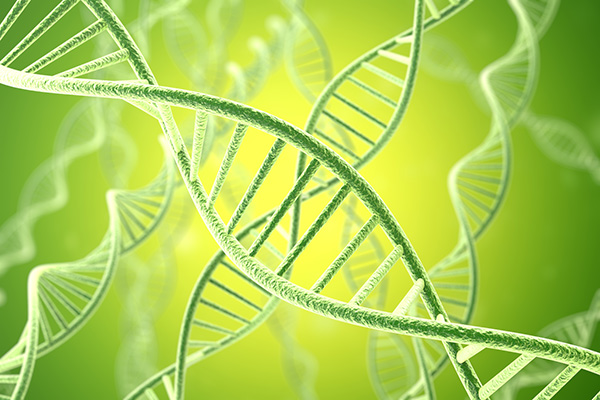Hereditary Breast and Ovarian cancer syndrome and the BRCA1 or BRCA2 genes
The BRCA1 and BRCA2 genes were the first genes identified as causing a very high risk of breast and ovarian cancer.
BRCA1 and BRCA2 are important for fixing the mistakes that occur in the DNA of cells. Specifically, they fix double strand breaks. The pathway is known as homologous repair. You can think of them as spell-checker genes. Scientists call them tumour suppressor genes.
The woman, Dr Mary-Claire King, who found the first gene, called it the B-R-C-A-1 gene. It stands for BReast CAncer One. But, just like most people named Christopher or Victoria are called Chris or Vicki, most people say BraCar. (Although, if you are ever around Dr King or are presenting at a genetics conference, make sure you spell BRCA1 out in letters: bee-are-sea-aye-one!).

Where do BRCA1 and BRCA2 mistakes come from?
Most of the time, germline genetic mutations are inherited, either from your father or your mother. (Yes, you can inherit breast cancer risk from your father!) While someone had to go first - this is called a de novo mutation - these genes are very stable and de novo mutations in the BRCA1 and BRCA2 genes are rare.
In some groups, such as the Ashkenazi Jewish population, there are specific mutations, called founder mutations, have been passed down over hundreds or even thousands of years. You can read more about founder mutationshere
So, while you are very unlikely to be the first person in your family to carry a germline (heritable) mutation, you may be the first person in your family to get a BRCA-related cancer.
How many people carry a BRCA1 or BRCA2 mutation?
It is estimated that in Australia 1 in 500 people carry a BRCA1 mutation and 1 in 225 people carry a BRCA2 mutation. These are called carrier frequencies and they vary depending on the population assessed. (It's about 1:50 for someone with Ashkenazi Jewish heritage.)
There are other important genes that work with BRCA1 and BRCA2. The most important are:
- PALB2 (partner and localiser of BRCA2)
- BRIP1 (BRCA1 Interacting Protein 1)
- ATM
- RAD51C and RAD51D
You can read more about the specific cancer risk associated with BRIP1, PALB2, RAD51C and RAD51D mutations, and what to do about that risk. The ATM gene has its own page (read it to find out why!).

What happens if you inherit a BRCA1 or BRCA2 mutation?
Women who have inherited a BRCA1 or BRCA2 mutation have a very high lifetime risk of breast cancer (40 to 80%) and ovarian cancer (10 to 40%). Men who have inherited a BRCA1 or BRCA2 mutation have an increased risk of breast (6 to 7%) and prostate cancer (8 to 15%). The risk depends on which gene is damaged. People who have inherited a mutation in BRCA2 also have a small but significant risk of developing pancreatic cancer (<5% over a lifetime) and this risk is doubled if they smoke.
Why isn't cancer risk 100% if you are BRCA positive?
BRCA genes don't cause cancer, they actually prevent it! It's when the gene isn't working that the risk goes up.
Everyone, whether they are male or female, gets 2 copies of these genes, one from each parent. The cancer risk is high but not 100% because the second copy of the gene is working. That means that the BRCA spellchecker can still be made, the DNA mistakes can still be fixed and you can still be protected from cancer.
Why do the cancers occur?
Over time, the random mistakes that occur in our DNA may damage or switch off the second working copy of the BRCA gene. Without a working spellchecker, the mistakes all cells make will build up much faster. That's why we see more cancers and cancers occurring at a younger age.
The risks are quoted as a range, even though no one gets 40% or 80% of a cancer. You can read about the actual risks measured in specific studies on the Cancer Genetics section of the Australian Government's Cancer Institute's eviQ website.

What to do if you carry a BRCA1 or BRCA2 gene mutation?
The mutation can be inherited from your mother or your father - the cancer risk is the same.
BRCA1 or BRCA2 gene mutations don't skip a generation. The genes are always present and they are either working or they're not. If you have inherited the same mutation that was present in your parent, there's a lot you can do to reduced your cancer risk. Options included:
- starting breast screening earlier, using more sensitive imaging such as MRI
- surgery to reduce the lifetime risk to less than 1 or 2%
- taking risk-reducing medications
Some women, like Angelina Jolie, who made these genes very famous in 2013 when she told Time Magazine that she had inherited a BRCA1 mutation from her mum, elect to have bilateral mastectomies. This is the most effective way to reduce breast cancer risk – the residual risk is tiny, less than 1 or 2% (compared to the 10 or 15% lifetime risk for the average Australian woman).
For women who don't have mastectomies but are 30 years or older annual breast screening with annual breast MRI +/- mammograms is recommended. The breast MRI’s are Medicare funded from age 30 to age 50, when many women switch to mammograms only. Screening before age 30 is rarely needed or recommended.
One of the most commonly used risk-reducing medications is Tamoxifen. It's made by Sandoz under the brand name Novolex-D. It's available on the PBS and generic forms are also available. It does have side-effects and some women who take it will still get breast cancer.

Angelina Jolie had her ovaries and fallopian tubes removed as well
There is no effective screening for ovarian cancer. The blood tests and ultrasounds are not able to detect the cancer cells when they first start to grow. That is, it gives a false negative result. This type of screening is also associated with a high false positive rate (finding a lump that is not cancer) requiring surgical intervention and has been shown to be harmful.
Ovarian cancer usually starts in the lining of the fallopian tube but can also start in the lining of the ovary and, rarely, the peritoneal lining. These cells are not stuck down like a polyp in the bowel or confined like a lump in the breast or prostate. That means the cells can be spread widely while the cancer is still microscopic.
The only safe way to reduce the risk is to remove the ovaries and fallopian tubes (you can't remove the peritoneal lining). This is called a risk reducing salpingo-oophorectomy (RRSO). It is laparoscopic (key-hole) surgery, usually only requiring a day in hospital. It is recommended at age 40 for a BRCA1 mutation carrier and age 45 for a BRCA2 mutation carrier, as this is when the risk starts to climb. This surgery is even recommended in women in their 80s if they are fit and healthy, as the risk doesn't go down after menopause.
Angelina's RRSO was MUCH more important than her breast surgery.
Hormonal replacement therapy is recommended up to the age of the natural menopause (age 50) for young women post RRSO, who have not had breast cancer. This protect the bones, brain, libido, heart - all the things oestrogen is important for. This does not have a significant impact on breast cancer risk when used in this way.
What does a BRCA mutation mean for a man?
Men who carry BRCA mutations are also at increased risk of breast cancer. Screening is not required. Instead, if a man finds a lump in his breast, notices changes in the skin over the breast or has a nipple discharge, he should see his doctor.
Prostate cancer risk is also increased - it's 3 or 4 times the average risk by age 70 and increases as the man ages.
Research has shown that if a prostate cancer develops in a man who carries a BRCA1 or BRCA2 mutation, it more likely to be aggressive and to spread (metastasise). PSA testing (the blood test that detects whether a prostate cancer is present) has been shown to help detect prostate cancers early in men with BRCA1 or BRCA2 mutations. PSA testing is recommended every year from age 40.

What about my children?
There is a 50% chance of a person who carries a BRCA1 or BRCA2 mutation, whether male or female, passing the mutation to their son or daughter. If a mutation is identified, then predictive testing would be available for adult blood relatives. This is Medicare-funded under item 73297..
Genetic testing for BRCA mutations is not offered to children aged under 18. This is because it would not alter their management and destroys their right to medical autonomy. Instead, predictive testing is recommended at age 18, when starting a family or when screening would start: age 30 for women and age 40 for men.
What if you inherit 2 mistakes, both in the same gene, one from each parent?
Most babied don't even grow if they inherit 2 pathogenic mutations in BRCA1 (embryonal lethality). A baby that inherits 2 mistakes in BRCA2 develops the very serious condition called Fanconi anaemia in childhood. You can read more about Fanconi anaemia here.
While you can inherit a mutation in both BRCA1 and BRCA2, this is very uncommon. It may occur some high risk groups such as individuals with Ashkenazi Jewish heritage. Management is based on the individual risk for each gene.
Can I prevent the BRCA mutation being passed on to my children?
Yes. Some families use preimplantation genetic diagnosis (PGD) in the setting of in vitro fertilisation (IVF) to prevent the familial mutation being passed on to future generations. There's a 50% chance each time an egg or sperm is made that it carries the BRCA mutation and 50% that it doesn't.
At the moment, we can't test the egg or the sperm without destroying it. Instead, at day 3 after fertilisation, one cell can be removed from the 8-cell embryo and the DNA checked. The family then uses the embryos that don't carry the mutation.
PGD + IVF can be expensive and doesn't fit with everyone's ethics or religion. However, it can be very good news for families to know that even today we have techniques to prevent a mutation that has caused a lot of trouble and heartache in a family from being passed on to the next generation.

What are the clues that you carry a BRCA1 or BRCA2 mutation?
BRCA mutations are more common in women with triple negative breast cancer. At diagnosis, the pathologist tests the cancer to see if the oestrogen receptor, progestrone receptor and/or the HER2 receptor is over expressed. A triple negative breast cancer does not over-express any of these 3 receptors. This testing guides treatment but is also a clue to inherited cancer risk.
For women diagnosed with triple negative cancer at or before age 50, research has shown that the likelihood she carries a BRCA mutation is 10% or greater, regardless of her family history of cancer. Under the eviQ guidelines, all these women should be offered publicly-funded genetic testing if seen via a public familial cancer clinic.
Medicare funded testing under item 73296 is available to individuals who have had breast and/or ovarian cancer and have a 10% chance of carrying a BRCA mutation. Specific calculators, such as the Manchester score or the CanRisk tool must be used and the test must be ordered by a specialist.
Self funded testing is also available if you don't meet either of these criteria.
In addition to triple negative breast cancer, other clues to a BRCA1 or BRCA2 mutation, regardless of the individual’s current age include:
- Male breast cancer.
- Breast cancer diagnosed under age 40.
- Bilateral breast cancer with first diagnosis under age 50.
- Ovarian cancer: high grade serous, endometrioid or clear cell.
- Pancreatic cancer.
- Metastatic prostate cancer or prostate cancer before age 55.
- Jewish heritage and a history of breast, ovarian, prostate or pancreatic cancer.

More information and support groups
Does this sound like you or your family? Has an BRCA1 or BRCA2 mutation been detected in a blood relative? Make an appointment with Dr Hilda High at Sydney Cancer Genetics. It is a confidential opportunity to discuss your personal and family history of cancer and genetic testing can be organised, if needed. You'll find information on how to make an appointment here
At Sydney Cancer Genetics, we are always happy to see individuals and families, either for testing to see if a BRCA1 or BRCA2 mutation is present or to discuss the implications and management if a mutation has already been found.
There are many support groups in Australia. Your local hospital probably has one. These are just a few national groups:
- Pink Hope
- Ovarian Cancer Australia
- The Cancer Council Get Support service. This is the NSW website but the 13 11 20 number is national.
- Prostate Cancer Foundation of Australia

